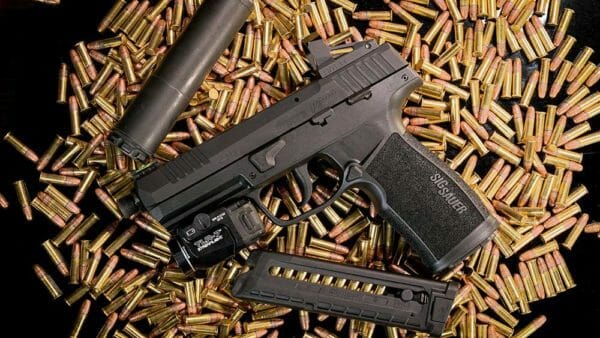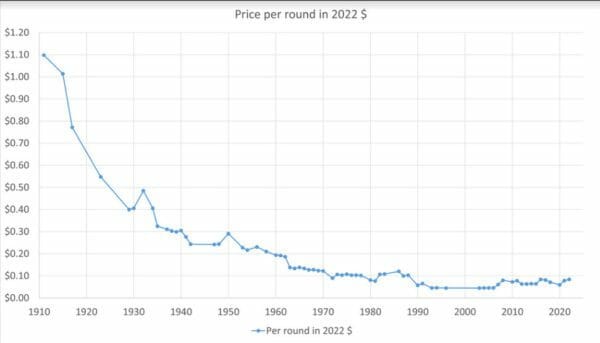https://www.ammoland.com/wp-content/uploads/2022/06/110-price-LR-in-Unskilled-Labor-dollars-1911-to-2022-972–500×286.jpg

U.S.A. –-(AmmoLand.com)-— The author has been interested in the historical costs of .22 rimfire cartridges since childhood. Starting in early adolescence, and continuing for many years, the value of things and time was measured in .22 cartridges. It was a simple calculation, an easy comparison. From that era, 1964 to the present, .22 Long Rifle cartridge list prices, converted to constant unskilled labor dollars, have been fairly stable.
The unskilled labor number is based on the time it takes for an unskilled laborer to earn the same purchasing power for a particular year. It took about 146 hours (about two weeks, 12 hours a day, six days a week), for an unskilled laborer in 1911, to earn the same purchasing power as 1 hour of unskilled labor in 2022. The chart shows the value of unskilled labor increased rapidly from 1911 to present, with some glitches. The most obvious is the depression, in 1932, post-WWII in 1950, most of the 1980s, and after the election of President Obama, 2008 onward.
The .22 caliber rimfire cartridges are the most successful cartridges in history. Billions are produced annually. They are the most used cartridges of all time. The .22 Long Rifle is the most common. For a considerable time, the .22 Short gave it significant competition. The .22 Long, while sold in considerable quantities, was never as popular as either the Long Rifle or the Short.
.22 rimfire cartridges have been used to kill the biggest land animals on the planet, from elephants (according to Peter Hathaway Capstick, in Safari, the Last Adventure, p.114 to 116) to grizzly bears.

The .22 Winchester Rimfire (WRF) and the .22 WRF magnum deserve mention, but their use and production pale in significance to the Long Rifle and the Short.
The .22 rimfire has always been the least expensive cartridge to purchase. For most of history, the .22 Short has been less expensive than the Long Rifle. That changed in the 1980s. The Long Rifle has always been more versatile.
This correspondent has obtained manufacturer price list information for .22 Long Rifle ammunition from 1911 to 2022. The information covers 111 ears of pricing history. Of the 111 years, this correspondent obtained data for 70 years. There are enough data points to catch most variations lasting a couple of years or more.
For consistency, the prices are those of smokeless, 40-grain high-velocity Long Rifle cartridges. The prices are all from one highly successful manufacturer. The cost of obtaining the prices was confidentiality.
Material costs seem to have relatively little effect on overall cartridge costs. Looking at a 2003 Gun Digest, variations of 50 rounds of .25 Auto and 50 rounds of .44 magnum were both priced at $17.
The incredible increase in productivity brought about by the petroleum age and increasing technological prowess reduced the relative costs of cartridges enormously. In 1911, the petroleum age was just starting. Automobiles were in their infancy. So were airplanes. The ability to fix nitrogen from the air for fertilizer and explosives had been discovered by German scientists in 1909, in the Haber-Bosch process.
In 1911, the relative cost of a thousand rounds of .22 Long Rifle, in dollars earned by unskilled labor, was $1,095, or about $1.10 per cartridge in 2022 valuation. The nominal cost in 1911 was 3/4 of a cent per round. To give perspective, butter was 20 cents a pound; fresh eggs were 20 cents a dozen. A day of unskilled labor was paid about $1.
After WWI and the vast increase in technological knowledge and skill, the cost fell to about 28 cents per round in the value of unskilled labor in 2022. WWII sparked more increases in technological prowess and knowledge. The price gradually fell to about 20 cents per round in 2022 unskilled labor dollars. The lowest prices, per round of .22 long rifle, in unskilled labor, were reached from 1993 to 2006, at about 4.5 cents per round.
From the Obama years onward, the price has gone up and down to about 8 cents per round currently. If we maintain a republic, this correspondent expects .22 Long Rifle cartridges to move back down in the neighborhood of 4 cents a cartridge in constant dollars.
Diligent shoppers will find cartridges on sale, going out of business, discontinued, or other bargains. Estates of shooters often sell ammunition at bargain-basement prices. Gun stores often refuse to resell ammunition, even in unopened boxes.
Ammunition, if stored in reasonable conditions, will last many decades, probably over a hundred years. 65-year-old .22 rimfire ammunition has been tested by this correspondent. There was no measurable degradation in performance.
—
About Dean Weingarten:
Dean Weingarten has been a peace officer, a military officer, was on the University of Wisconsin Pistol Team for four years, and was first certified to teach firearms safety in 1973. He taught the Arizona concealed carry course for fifteen years until the goal of Constitutional Carry was attained. He has degrees in meteorology and mining engineering, and retired from the Department of Defense after a 30 year career in Army Research, Development, Testing, and Evaluation.

AmmoLand.com